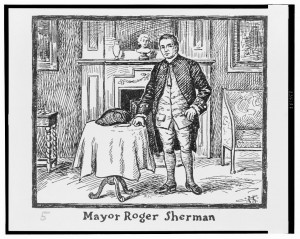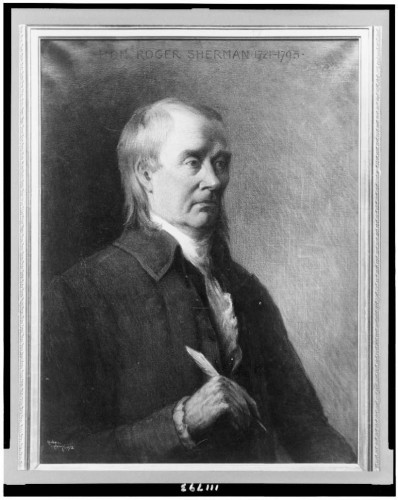By Gregg Mangan
Roger Sherman is the only person to have signed all four of the most significant documents in our nation’s early history: the Continental Association from the first Continental Congress, the Declaration of Independence, the Articles of Confederation, and the United States Constitution. He began life as a surveyor and a cordwainer (someone who makes shoes and other items from leather) before establishing himself as a political icon of the American Revolution. He spent the last 30 years of his life devoted to public service, often simultaneously holding multiple high-profile political and judicial positions. Known for his sensibility and control over his emotions, Sherman was, in Thomas Jefferson’s words, “a man who never said a foolish thing in his life.”
Born in Newton, Massachusetts, on April 19, 1721, Roger Sherman was the second of seven children born to William and Mehetabel Sherman. William was a farmer, as well as a cordwainer, and helped teach Roger his early trade. A natural ability with numbers helped Roger teach himself surveying. When Roger was 19, William died and Roger assumed responsibility for his father’s estate. He moved the family in June of 1743 to join oldest brother William in New Milford.

Sherman House, Main Street, New Milford, 1872 – Connecticut Museum of Culture and History. Used through Public Domain.
Sherman’s self-discipline with his surveyor training paid off two years later, when the Connecticut General Assembly appointed him the surveyor of New Haven County and, later, Litchfield County, a post he held until resigning in 1758. It was during these years in New Milford that Roger began to actively participate in town affairs, perhaps motivated by his growing interest in land speculation. It was also at this time that he married his wife, Elizabeth Hartwell. Roger and Elizabeth wed on November 17, 1749, and had seven children. His three oldest sons would serve as officers in the Continental army.
Roger soon expanded his interests into retail, opening a store that sold tables, chairs, brooms, razors, and other household items. He also began publishing almanacs. In his almanacs, Sherman included entries on astronomy, religious festivals, weather, and his views on the values of colonial currencies. These pursuits did not keep his attention for long, however. Roger began spending more time surveying and also took up the study of the law. Sherman passed the bar in February of 1754 and the following year became justice of the peace for Litchfield County, an appointment that coincided with his election to Connecticut’s General Assembly. Shortly after the death of his wife in October of 1760, he resigned his political post and moved his children to New Haven.
Civic Service in New Haven
After arriving in New Haven, Sherman gave up practicing law, as well as surveying, and once again settled into life as a merchant, opening a store of books and general merchandise located across from Yale College. Not long after, as he was returning from a visit to his brother in Woburn, Massachusetts, Rebecca Prescott, the niece of his brother’s wife, passed by him on the road. Roger turned his horse around and headed back toward Woburn to begin a courtship that ended in his marriage to the 20-year-old Prescott on May 12, 1763. Roger’s second marriage resulted in the birth of eight more children.
A rapid succession of political appointments followed Sherman’s marriage. In 1764 he was again elected to the General Assembly and in 1765 appointed justice of the peace for New Haven County. Shortly after, he took on the additional responsibility of being the treasurer of Yale College, a post he held until 1776.
“no laws bind the people but such as they consent to be Governed by”
The tide of sentiment that was rising in the colonies at this time did not fail to capture Sherman’s interest. The increasingly restrictive policies of the British parliament resulted in the passing of numerous acts aimed at garnering revenue from the American colonies. Parliament passed these acts without colonial consent. The announcement of the 1773 Tea Act motivated Sherman to declare his belief “that no laws bind the people but such as they consent to be Governed by.” His reputation of service to the colony, along with his strong patriot sentiment, got him elected as a delegate to the first Continental Congress.
Sherman excelled in his new work at the national level. Throughout the Revolutionary Era, he was known as a steadfast worker and an informed, attentive legislator. He is reported to have risen every morning at 5:00 a.m., begun work at 7:00 a.m., and continued working until around 10:00 p.m. Sherman was placed on the committees that drew up the Declaration of Independence and the Articles of Confederation (the new nation’s first constitution). He involved himself in issues of supply purchasing, Native American affairs, and the administration of the post office. In addition, he served on the Board of War in 1776 and on the Board of Treasury. Sherman proved a capable and efficient legislator, despite what some perceived as a lack of polish in his oratory skills. His good friend John Adams described him as “one of the most sensible men in the world,” possessing the “clearest head and steadiest heart,” but poked fun at his manner of public speaking. “Sherman’s air,” Adams quipped, “is the reverse of grace; there cannot be a more striking contrast to beautiful action than the motion of his hands…it is stiffness and awkwardness itself, rigid as starched linen.”

Mayor Roger Sherman, 1911 – From sketches by Irving E. Hurlburt, Reproduced in: The New Haven Almanack, 1912, Library of Congress, Prints and Photographs Division. Used through Public Domain.
In 1784, Sherman returned from Congress and was elected the first mayor of the newly incorporated city of New Haven. Three years later, while still mayor of New Haven and a judge of the Superior Court in Connecticut, he was sent to represent Connecticut at the Philadelphia Convention. At the convention, Sherman was integral in shaping the country’s new constitution. In addition to being a vocal supporter of Alexander Hamilton’s proposal for federal assumption of states’ debts, he is credited with fathering the Connecticut Compromise, which ultimately led to the formation of a bicameral legislature (with the size of representation in the House being based on a state’s population, but the size of each state’s representation in the Senate being equal).
A Lasting Legacy to the Nation
After his service at the Philadelphia Convention, the Connecticut General Assembly elected Roger to serve in the US House of Representatives in 1789. The posting conflicted with his judicial responsibilities and Sherman was forced to resign from his judgeship. Two years later, William Samuel Johnson resigned his Senate seat to concentrate on his duties at Columbia College in New York City. Sherman was quickly named as Johnson’s replacement. His service only lasted until March of 1793, however, when he returned home to New Haven due to failing health. On July 23, 1793, Roger Sherman died of typhoid fever.
Sherman’s legacy is one of dedicated public service. Not only did he devote a large portion of his life to politics, but his grandson, Roger Sherman Baldwin, went on to serve both as a US senator and as governor of Connecticut. Two of his other grandsons, George F. Hoar and William M. Evarts, also served as US senators, with Evarts serving as secretary of state under President Rutherford B. Hayes. Sherman’s meticulous nature and ability to control his emotions made him a leader in many critical decision-making processes during the founding of the United States. Fisher Ames, a leader in the House of Representatives, once remarked that if he [Ames] was ever absent from a debate, when it came time to vote on the issue, he “always felt safe in voting as Mr. Sherman did; for he always voted right.”
Gregg Mangan is an author and historian who holds a PhD in public history from Arizona State University.









